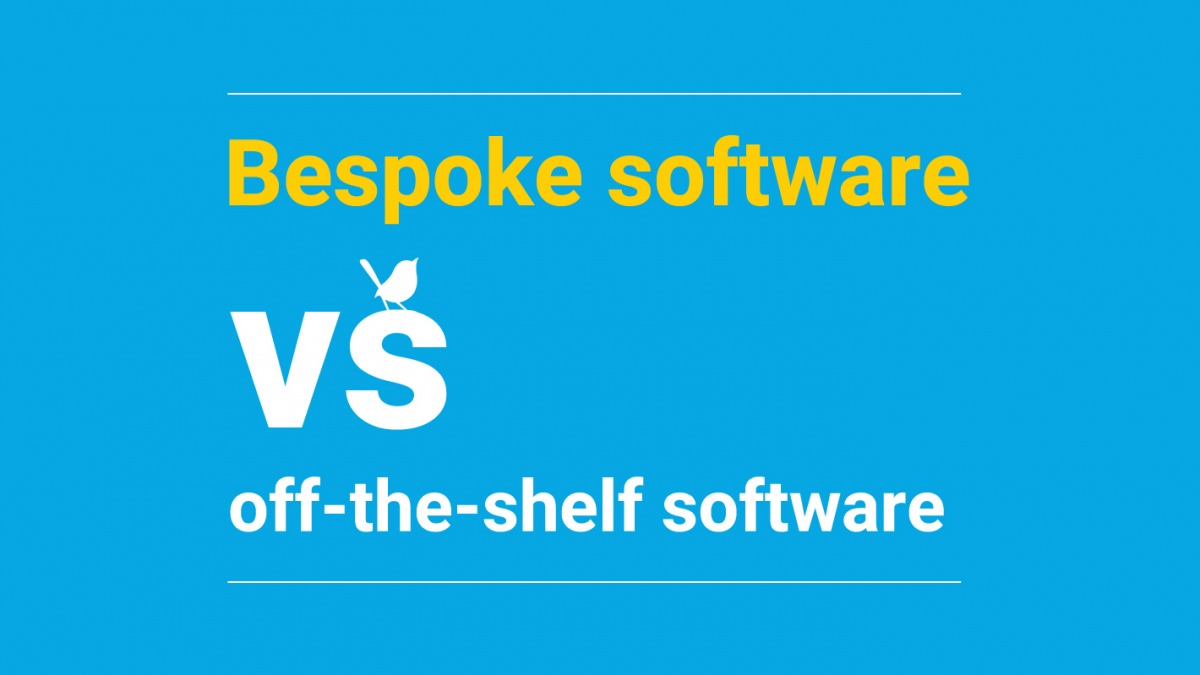Bespoke software vs off-the-shelf software
04 January 2018

Your company’s choice of software is critical to your business’ performance.
Off-the-shelf software is a product that you buy and use without customisation – take Microsoft’s Office Suite or Adobe Photoshop for example.
Bespoke software is designed and built on demand with a specific purpose in mind for the organisation that has commissioned the build. In this piece, we take a look at the advantages and disadvantages for both bespoke and off-the-shelf software solutions.
Flexibility and Customisability
Off-the-shelf
Whatever task you want to complete, there’s software to tackle it. However, with off-the-shelf software you often make compromises. It’s more generic because it has been built for a much wider audience. That’s not to say that the software won’t do broadly what you want, but there is likely to be a host of features that you don’t need. Microsoft Word; how often do you use its Smart Lookup or referencing functions? Handy for some, but not why most people buy it.
Bespoke
You have total control of the features in a bespoke application. It’s designed to tackle your unique requirements. As your company grows and changes, so can your bespoke software.
We implement Agile project management, so you see the progress of the software throughout its development. This level of transparency allows for valuable feedback, meaning the project is flexible throughout its development, and beyond.
Functionality
Off-the-shelf
Off-the-shelf software is suitable for a mass-market, so has typically undergone vast testing – from focus groups to beta testers. You receive a product with carefully considered functionality and it is designed to suit the majority and not necessarily the individual.
It is likely that it has been created by numerous developers. However, there’s no guarantee it won’t be overly complicated for what you need it to do, or not quite do what you want it to.
Bespoke
The functionality represents what works best for you. It’s built alongside your current processes. It’s previewed and tested by you, so if there is any aspect of the functionality that you don’t like, you can simply request it to be changed.
Because the functionality is built in consultation with you, it allows for a free exchange of ideas, where you can shape exactly what the product delivers.
Help and Support
Off-the-shelf
Off-the-shelf software is used by a larger number of people; there is likely a support and help function online, and even forums and online communities that may have asked and answered many of your questions.
If there isn’t an answer to your question, you can be left frustrated and stuck without a solution to your problem based on the limitations of the application.
Bespoke
You have direct communication with the people who developed your bespoke software solution, this allows you to communicate directly to those who understand your business and how the software application works for you. This means response and support can be more personal, tailored and effective.
Training
Off-the-shelf
If the software is popular, you may not need to train your team how to use it. They may already know. There could even be training courses conducted by a specialist. Alternatively, you may find the software is so complex that it requires extensive training or your team does not engage with its full functionality and chooses to only use it sparingly. You risk having an expensive tool that no-one likes and no-one uses.
Bespoke
With the software being engineered for your business, no one will have prior experience, so training is inevitable. However, because it’s bespoke to you, it’s built to work in line with your processes.
As part of the close working relationship with your development team, you gain hands-on experience alongside the software’s creator. If anything is too complex, it can be changed. It also means the workflow can be matched to your business, making it easy for your team to adopt and use.
Integration into your current processes
Off-the-shelf
If you introduce an off-the-shelf package into your current processes, you may find that you need to adapt to accommodate it. This could lead to resistance from team members.
It’s also worth considering what will happen when your company grows and how the software is going to work for your business in the future. Do you lose your data if you ‘turn-off’ your subscription?
Bespoke
With bespoke software, integration with process and other systems is one of the key considerations. Bespoke software can be designed to seamlessly integrate with existing data, systems and processes to enhance operational efficiency and not hinder it. And if your company grows, the software can be customised and adapt with you.
Price
Off-the-shelf
The production costs for off-the-shelf software are spread across thousands of users, so it has a lower buy-in. However, you typically need to pay for additional users. So, as you grow, you’re faced with growing fees. And if you require specific modifications and integrations then these are additional costs.
Bespoke
Bespoke software will generally cost more initially, simply because it’s built to your unique specifications. However, your software will be designed to scale alongside your company’s growth meaning further enhancements will come at minimal cost. Furthermore, bespoke software is designed to do exactly what you need it to, that means it should deliver greater levels of operational efficiency and lead to increased productivity.
Would you like to learn more about Bespoke Software?
We can rapidly deliver a cost-effective, bespoke software solution that is unique to your business. Working closely with your team, we will use our award-winning Flight platform to create your bespoke software solution.
It is unique to your business and delivered in a fraction of the time and cost of a ground-up development. After launch, the software can be easily changed and tweaked as your requirements evolve, without any additional cost.
Categories
Productivity
In this article learn:
- the key differences between bespoke software and off-the-shelf solutions
- which may be most suitable for your business
- the impact they can have on your business, processes and productivity
Further reading:
- Key productivity metrics and how to measure them
- 5 signs that your processes are holding you back
- Why your business needs to embrace digital transformation
- 8 steps to process improvement for a growing business
- The three pillars of productivity: engagement
- The three pillars of productivity: integration
- The three pillars of productivity: process improvement
- How bespoke software boosts productivity
- How software promotes a positive culture in the workplace
- Why your business needs to embrace digital transformation

